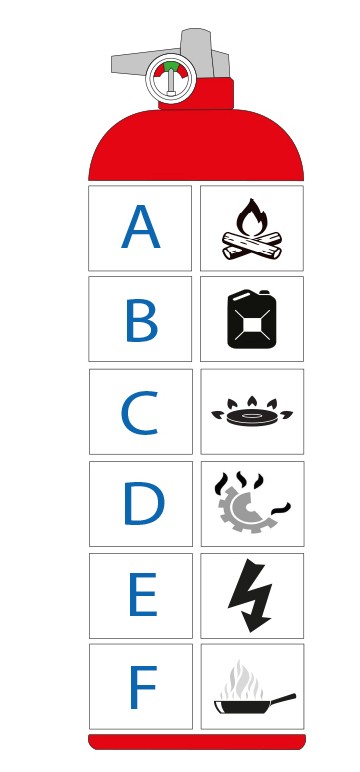In the UK the different types of fire classes are classified using the European Standard Classification of Fires BS EN3, which is recognised across the EU.
There are six different types of fire classes which are based on the energy source that has caused them.

Class A – fires involving solid materials such as wood, paper or textiles.
Class B – fires involving flammable liquids such as petrol, diesel or oils.
Class C – fires involving gases.
Class D – fires involving metals.
Electrical – fires involving live electrical apparatus.
Class F – fires involving cooking oils such as in deep-fat fryers
One of the main reasons why it is important to understand the different classifications of fire is to understand which fire extinguisher to use as there are different types that should be used according to the energy source.
Classifying a fire according to its energy source also makes it easier to choose the most appropriate method of fighting the fire. For example, some types of fire extinguisher are better suited for use on certain types of fires than others.
Using the wrong type of fire extinguisher on certain fires could cause more harm than good, and create an even bigger catastrophe, so it is important to understand the energy source before selecting the equipment required to extinguish a fire.
The following are the fire classifications used in the UK:
Class A – Ordinary combustible fires
Materials involved in these types of fires include paper, wood, textiles, rubber, some plastics and other organic carbon-based compounds. These often emit harmful gases usch as carbon dioxide.
Class A fires involving the above energy sources can be extinguished using appliances and fire extinguishers that spray water. The water cools the fire, removing the heat supply which is essential for the fire to burn.
These fire are best extinguished using foam, dry powder, CO2 or Firexo fire extinguishers.
Class B – Flammable liquids
Examples of liquids that are flammable include petrol, kerosene, alcohol, solvents and paints. Fires involving these volatile chemicals burn at a very high temperature, give of lots of heat and often spread quickly. These fires also produce toxic smoke and fumes, which can make situations involving these types of risks very difficult to control.
These fire are best extinguished using foam, dry powder, CO2 or Firexo fire extinguishers.
Class C – Flammable gases
Commercial premises used to store flammable gases such as butane, propane and petroleum gases can be very dangerous. Even a single spark has the potential to create an explosion consequently there are many laws to ensure flammable gases are stored securely in sealed containers and many insurers insist on having additional gas detection systems installed to provide an early signs of gas leakage.
Fires involving flammable gases are one of the hardest fires to put out as it can be hard to isolate the source of leakage and stop the release of gas or flammable liquid.
Dry powder or Firexo extinguishers are the most appropriate flammable gas and chemical extinguisher.
Class D – Combustible Metal
It requires a lot of heat to ignite most metals, but metals are good conductors and transfer heat away quickly to their surroundings so can be the cause of a fire. Powdered metals and metal shavings are easier to ignite than solid lumps of metal and therefore a much higher fire risk.
Only certain metals are flammable. Examples of combustible metals include sodium, potassium, uranium, lithium, plutonium and calcium. Most class D fires involve magnesium and titanium.
Standard fire extinguishers will not put out a class D fire and, if used on this type of risk, will almost certainly make the situation worse.
These fires are best extinguished using dry powder, CO2or Firexo fire extinguishers.
Class E – Electrical fires
Electrical fires can be caused by faulty equipment, damaged wiring, short circuits, and overloaded switchboards and sockets. Although electrical fires are not strictly a fire class of their own, electricity is classed as a source of ignition and has its own special fire safety requirements.
You should never try to extinguish a fire caused by electricity using water or foam as this acts as a conduit and could electrocute the person holding the appliance. Contractors who might be carrying out works on energized electrical equipment should take extra fire protection precautions.
These fires are best extinguished using dry powder or Firexo fire extinguishers.
Class F – Cooking oil fires
Class F fires involve cooking oil and fats. These ignite at very high temperatures making them difficult to extinguish.
Standard fire extinguishers will not put out a class F fire and, if used on this type of risk, will almost certainly make the situation worse.
The only fire extinguisher suitable for use on cooking oil fires are wet chemical or Firexo extinguishers.
If you need advice on which fire extinguishers to install for your business please read our article on types of fire extinguisher.
Tecserv UK is also an approved distributor for Firexo a new type of multi-purpose fire extinguishing product that aims to remove the risk associated with the time that can be wasted checking which type of fire extinguisher should be used according to the type of fire class.

Mark has spent his working career in the fire alarm industry, in which he is highly respected by his colleagues and competitors alike. Mark often provides technical support to other fire alarm companies and even alarm equipment manufacturers. He also uses his experience to train engineering personnel.